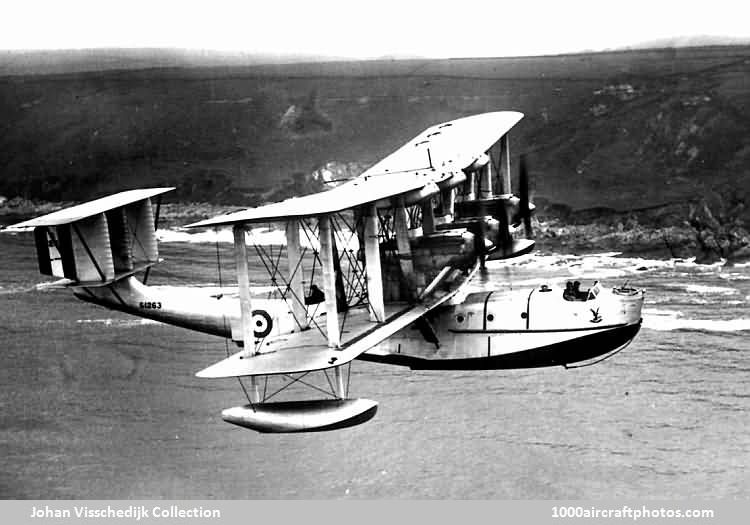09/30/2016. Remarks by Johan Visschedijk: "Blackburn had first entered the field of flying boat design with the N.1B, a single-seat fleet escort bomber that had been partially built in 1917-18, but never flown. Subsequently, the hull of this aircraft was used in the Blackburn Pellet, an unsuccessful contender for the 1923 Schneider Trophy Contest. Unfortunately, the Pellet crashed whilst taking off on the day of the race. Notwithstanding this initial lack of success, in 1924 Blackburn responded to RAF specification 14/24 for a long-range reconnaissance flying boat. Since Blackburn's experience with the Pellet, the company had been fortunate in obtaining the services of Major J.D. Rennie. Major Rennie was the ex-Chief Technical Officer of John Porte who had been instrumental in the design of the extremely successful WW I series of Porte-Felixstowe flying boats.
R.B.1 Iris Mk.I. Under Rennie's guidance, Blackburn's submission was a large aircraft of wooden construction powered by three 650 hp Rolls-Royce Condor III engines. Completed in 1926, this aircraft with the RAF serial N185 was called the Iris. First flown on June 19, 1926, the Iris had an excellent performance and was capable of sustained flight on any two of its three engines. Full performance trials were carried out shortly after the first flight by the MAEE at Felixstowe during July and August.
R.B.1A Iris Mk.II. Although the Iris performed well, it was hampered by its wooden hull, which could absorb water to a weight of 200-300 lb (91-136 kg). Such a weight addition was obviously detrimental to performance at sea and in the air and so consequently the Iris was redesigned with an all-metal hull. The new hull was constructed of duralumin and differed in several respects from the original wooden hull. At the same time as the new hull was fitted to N185, it was also re-engined with three 675 hp Condor IIIA engines. So modified, N185 became the sole Mk.II.
In August 1927 the Iris Mk.II in company with a Supermarine Southampton, a Short Singapore and a Saunders Valkyrie embarked on a 9,400 mile (15,128 km) tour of the Baltic. The Iris was designated the flagship for this tour and as such carried Sir Samuel Hoare who was then the Secretary of State for Air. So successful was the Iris that the aircraft was selected to carry Sir Phillip Sassoon, the Under Secretary of State for Air, on his 17,000-mile (27,359 km) tour to India in the following year.
R.B.1B Iris Mk.III. Largely as a result of this success in transporting VIPs, the Air Ministry issued specification R.31/27, to cover the production of a developed Iris that it was planned would equip one squadron. This aeroplane became the Iris Mk.III and was similar to the Mk.II but was constructed entirely of duralumin with fabric covering for the flying surfaces. The engines fitted were three 675 hp Condor IIIB engines.
The prototype Iris Mk.III, serial N238, was first flown on November 21, 1929 and was immediately found to be superior to the Mk.II in most respects. The Iris Mk.III entered service with No. 209 Squadron which reformed at Mount Batten, Plymouth in January 1930. By July 1931 the squadron was operating three aircraft, S1263, S1264 and S1593. This latter aircraft was a replacement for N238, which had unfortunately crashed in February 1931, and was fitted with a 37 mm C.O.W. quick-firing cannon in the bow.
During its service career the Iris Mk.III performed admirably. In June 1930 S1263 and S1264 flew to Reykjavik for the Icelandic Parliament's millenary celebrations and in the following August S1264 flew non-stop to Lisbon in the excellent time of 10 hours 50 minutes. In the spring of 1931, S1263 and S1264 embarked on an extremely successful tour of the Mediterranean, both aircraft returning before the summer.
R.B.1C Iris Mk.IV. As early as December 1926 Rennie had prepared a scheme for an Iris Mk.II powered by three 700 hp Armstrong Siddeley Leopard two-row air-cooled radials. He envisaged a saving structural weight coupled with improved performance. No action was taken immediately, but, while work was in progress on the Iris Mk.III contract, Iris Mk.II N185 was sent back to the makers to be reworked and fitted with three of the latest 800 hp Leopard IIIs but with the center engine reversed for investigations into the cooling of pusher radials and to compare the efficiency of tractor and pusher airscrews. Its first flight in this condition, as the Iris Mk.IV, was made on May 6, 1931 piloted by A.M. Blake, after which it went to Felixstowe. After further work at the factory it was redelivered to the MAEE in March 1932.
R.B.1D Iris Mk.V. Although the Iris Mk.IIIs were successful, escalating weight caused by additional equipment was taking its toll, both of water and aerial performance. Consequently, in late 1931, the Air Ministry authorized the modification of all three Iris Mk.IIIs (S1263, S1264, S1593) to Mk.V standard, by the installation of the more powerful 825 hp Rolls-Royce Buzzard IIMS. These engines were mounted in new, low-drag nacelles of advances design directly on the interplane struts. By January 1933 all three had been modified, which resulted in a considerable improvement in flying qualities but not the hoped for improvement in sea handling.
R.B.3 Iris Mk.VI. On December 10 1932, the Iris Mk.V S1593 was returned to Blackburn and received a number of experimental installations including Fairey-Read metal airscrews, two-bladed outboard and four-bladed on the center engine. Referred to as the Iris Mk.VI it was flown again on March 31, 1933 and became the prototype of the R.B.3A Perth.
Although the Iris and Perth were built in very few numbers their benefit to the RAF was huge. From their usage the RAF gained great experience in the operation and maintenance of very large aircraft and the pioneering work carried out by the Iris and Perth was to prove invaluable in future operations of Coastal Command."
